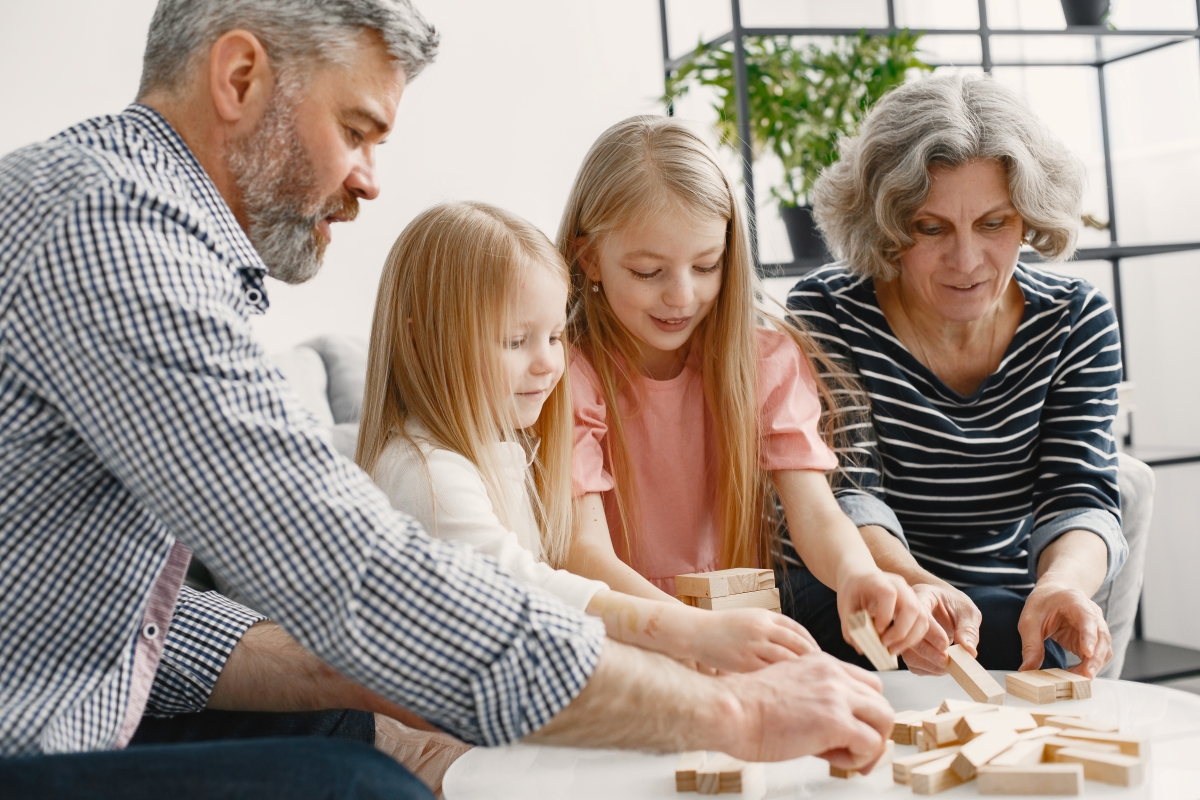Intergenerational Activities: Connecting with Younger Generations

In today’s fast-paced world, where technology advances rapidly, and lifestyles shift, it’s easy to overlook the profound benefits of connecting across generations. Intergenerational activities—those that bring together people from different age groups—serve as a bridge, enriching lives and strengthening bonds. For seniors aged 45 to 75, engaging with younger generations through shared activities can offer immense emotional, mental, and physical benefits while simultaneously imparting wisdom and fostering mutual respect. This article explores the transformative power of intergenerational activities and provides practical suggestions for creating meaningful connections.
Benefits of Intergenerational Activities for Seniors

Emotional Well-being
One of the most immediate benefits of intergenerational activities is the enhancement of emotional well-being. Loneliness and isolation are common issues among seniors, often exacerbated by reduced social circles or mobility challenges. Engaging in activities with younger people can combat these feelings by providing companionship and a sense of belonging. Whether through family gatherings, community programs, or casual meet-ups, these interactions help seniors feel valued and included.
Additionally, intergenerational connections can provide emotional support during challenging times. The presence of younger people in a senior’s life can offer a fresh perspective and a source of encouragement, helping to uplift spirits and foster a positive outlook.
Mental Health Benefits
Staying mentally active is crucial for cognitive health, and intergenerational activities offer excellent opportunities for mental stimulation. Conversations with younger generations can introduce new ideas and perspectives, keeping the mind engaged. For instance, discussing current events or learning about emerging technologies from younger people can stimulate intellectual curiosity and promote lifelong learning.
Engaging in activities that require problem-solving or creativity, such as crafting or cooking, further helps to sharpen cognitive abilities. Regular mental stimulation through these activities can contribute to a reduced risk of cognitive decline and conditions like dementia.
Physical Activity
Physical well-being is another area where intergenerational activities can make a significant impact. Many activities, such as playing gentle sports, gardening, or even walking, involve physical movement that benefits overall health. For seniors, staying active is essential for maintaining mobility, flexibility, and strength. Participating in these activities with younger generations can provide motivation and make exercise more enjoyable.
Moreover, engaging in physical activities together can lead to improved cardiovascular health and better management of conditions like arthritis or diabetes. The social aspect of these activities also encourages consistency, making it easier for seniors to stick to a routine.
Purpose and Legacy
Sharing experiences, wisdom, and skills with younger generations gives seniors a sense of purpose. Whether it’s recounting life stories, passing down family traditions, or teaching a new skill, these interactions allow seniors to contribute meaningfully to the lives of others. This sense of legacy and purpose can be incredibly fulfilling, providing a deeper connection to family and community.
Seniors often find joy in knowing that their knowledge and experiences are valued and preserved for future generations. This can enhance self-esteem and provide a lasting impact that extends beyond their own lives.
Benefits for Younger Generations
Learning from Life Experience
Younger generations stand to gain immensely from interactions with seniors. The wisdom and life experiences that seniors offer are invaluable learning resources. Through storytelling and shared experiences, younger individuals can gain insights into historical events, cultural practices, and personal growth.
These interactions provide a unique educational opportunity that goes beyond textbooks and classroom learning. Understanding the challenges and triumphs of previous generations can foster a deeper appreciation for history and personal resilience.
Respect and Empathy
Building relationships with seniors helps younger generations develop respect and empathy. Exposure to the aging process and its associated challenges encourages understanding and reduces age-related stereotypes. Engaging with seniors helps younger people recognize the value of every stage of life and fosters an attitude of gratitude and respect for the experiences of others.
Building Meaningful Connections
Intergenerational activities offer younger individuals the chance to build meaningful relationships outside their peer group. These connections can provide emotional support, mentorship, and a sense of community. By interacting with seniors, younger generations can develop stronger family ties and create a network of supportive relationships that extend beyond their immediate circle.
Popular Intergenerational Activities

Technology Tutoring
In today’s digital age, technology can be a great equalizer. Younger generations can assist seniors in navigating the world of smartphones, tablets, and social media. Technology tutoring sessions provide a platform for meaningful interaction while helping seniors stay connected with friends and family. Learning to use new apps or social media platforms can empower seniors to engage more fully with their digital lives.
For younger people, teaching technology offers a sense of accomplishment and the opportunity to share their skills in a meaningful way. The exchange of knowledge also provides a common ground for building connections.
Storytelling and Oral Histories
Storytelling is a powerful way to bridge generational gaps. Seniors can share their life stories, family histories, and personal experiences with younger generations. This exchange not only preserves valuable historical and cultural information but also fosters a deeper understanding between age groups.
Younger generations can benefit from hearing firsthand accounts of historical events, family traditions, and personal challenges. Recording these stories or creating family history projects can also provide a tangible way to honor and preserve the legacy of seniors.
Arts and Crafts Projects
Arts and crafts offer a creative outlet for intergenerational bonding. Seniors and younger individuals can collaborate on projects such as scrapbooking, painting, or knitting. These activities allow for self-expression while providing a space for shared creativity.
Crafting together can be a relaxing and enjoyable experience, offering opportunities for conversation and collaboration. The finished projects serve as lasting mementos of the time spent together, reinforcing the bond between participants.
Gardening
Gardening is a rewarding activity that can be enjoyed by people of all ages. Seniors can share their gardening knowledge and techniques with younger generations, or they can collaborate on planting and maintaining a garden. Gardening promotes physical activity, provides fresh produce, and offers a sense of accomplishment.
For younger individuals, learning about plants, soil, and garden design can be both educational and enjoyable. Working together in the garden also creates a shared experience that fosters connection and collaboration.
Cooking and Baking
Cooking and baking provide opportunities for intergenerational bonding over food. Seniors can teach younger generations traditional family recipes, share cooking techniques, and pass down culinary traditions. These sessions not only create delicious meals but also offer valuable lessons in cooking and nutrition.
Younger people can contribute by helping with meal preparation, experimenting with new recipes, or learning about different cuisines. Cooking together fosters teamwork and creates a space for conversation and connection.
Outdoor Activities and Sports
Engaging in outdoor activities and sports is a great way to stay active and have fun together. Seniors and younger individuals can participate in activities such as walking, hiking, or playing gentle sports like bowling or bocce ball. These activities promote physical health while providing opportunities for social interaction.
Outdoor activities offer a chance to enjoy nature, explore new environments, and experience the benefits of exercise. Sharing these experiences can strengthen relationships and create lasting memories.
Community-Based Intergenerational Programs
Mentorship and Volunteering
Many communities offer programs that facilitate intergenerational connections through mentorship and volunteering. Seniors can mentor younger individuals in areas such as academics, career development, or personal growth. These relationships provide valuable guidance and support for younger generations while offering seniors a sense of purpose.
Volunteering together on community projects also fosters teamwork and strengthens community ties. Whether it’s working at a local food bank or participating in environmental initiatives, these activities benefit both seniors and younger people.
Intergenerational Learning Programs
Schools and community centers often host programs that bring together seniors and younger individuals for shared learning experiences. These programs might include classes, workshops, or discussion groups that focus on topics of mutual interest.
Intergenerational learning programs offer structured opportunities for interaction, allowing participants to explore new subjects and share their knowledge. These programs can also provide a platform for building relationships and fostering understanding between age groups.
Cultural or Historical Events
Participating in cultural or historical events together provides a way to connect while celebrating shared heritage. Attending museum exhibits, historical reenactments, or cultural festivals offers opportunities for learning and appreciation.
These events also serve as conversation starters, allowing seniors and younger individuals to discuss their perspectives on history, culture, and traditions. Sharing these experiences strengthens bonds and deepens mutual respect.
Tips for Facilitating Successful Intergenerational Activities

- Choosing Activities that Appeal to Both Generations: To ensure successful intergenerational interactions, it’s important to choose activities that appeal to both seniors and younger individuals. Consider interests, preferences, and energy levels when selecting activities. Finding common ground helps create engaging and enjoyable experiences for everyone involved.
- Patience and Understanding: Navigating generational differences requires patience and understanding. Communication styles, preferences, and expectations may vary between age groups. Approaching interactions with an open mind and a willingness to adapt fosters positive relationships and minimizes misunderstandings.
- Consistency in Engagement: Building strong intergenerational connections takes time and consistency. Regular engagement helps reinforce relationships and creates a sense of continuity. Whether through scheduled activities or spontaneous interactions, maintaining consistent contact strengthens bonds and enhances the impact of shared experiences.
Conclusion
Intergenerational activities offer a powerful way to connect with younger generations, providing numerous benefits for both seniors and younger individuals. By engaging in shared experiences, seniors can combat loneliness, stay mentally and physically active, and find a renewed sense of purpose. At the same time, younger generations gain valuable insights, develop respect for aging, and build meaningful relationships.
Embracing intergenerational activities enriches lives, strengthens family and community ties, and fosters mutual understanding across age groups. Whether through technology tutoring, storytelling, crafting, or outdoor adventures, these interactions create lasting memories and contribute to a more connected and empathetic society. As we continue to navigate the complexities of modern life, fostering these connections remains a vital and rewarding endeavor.





